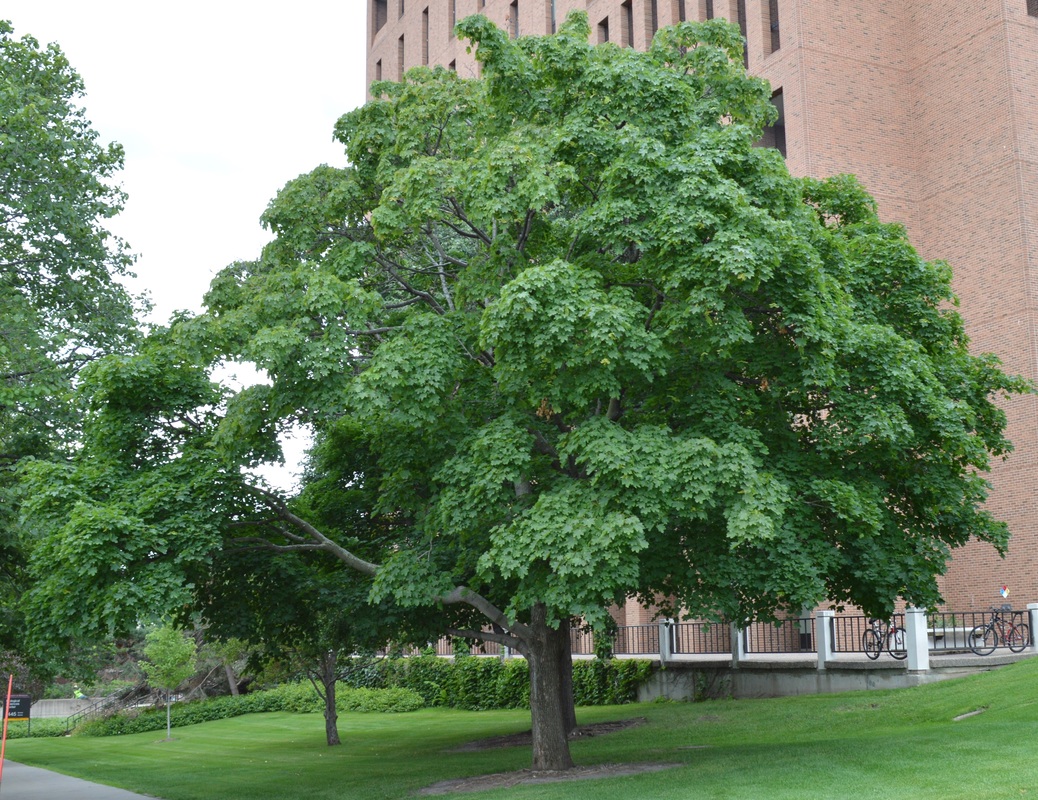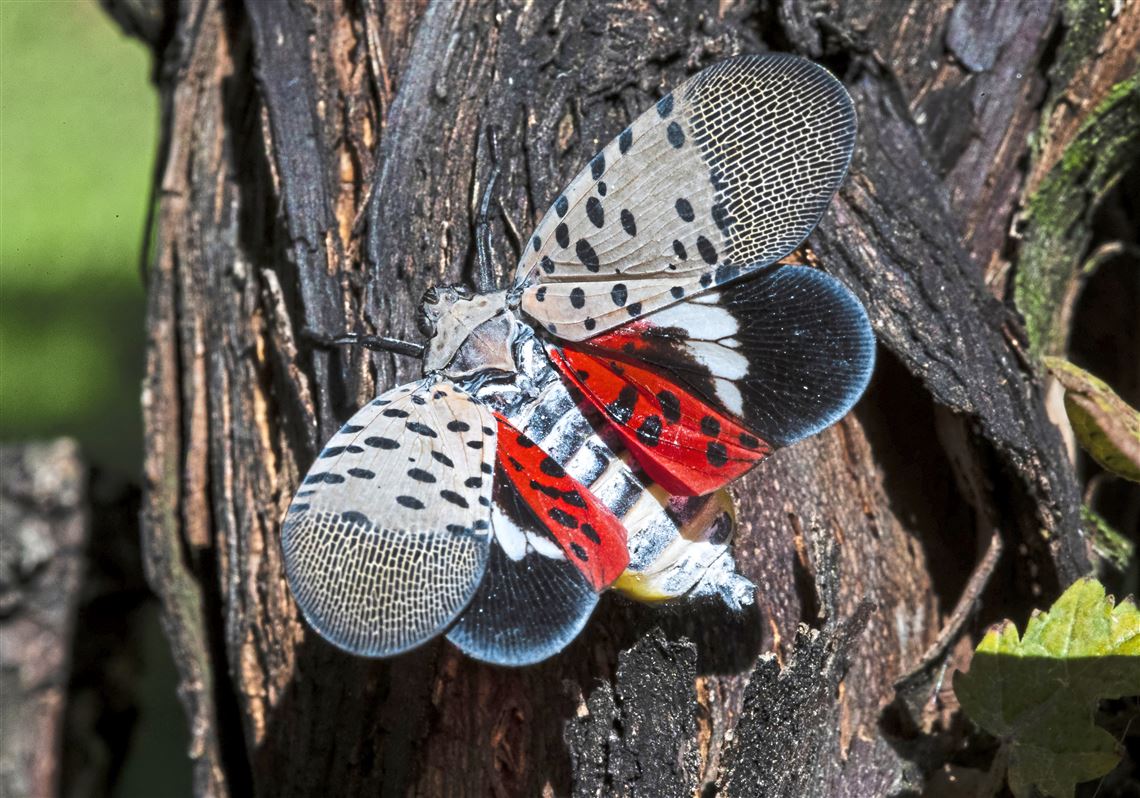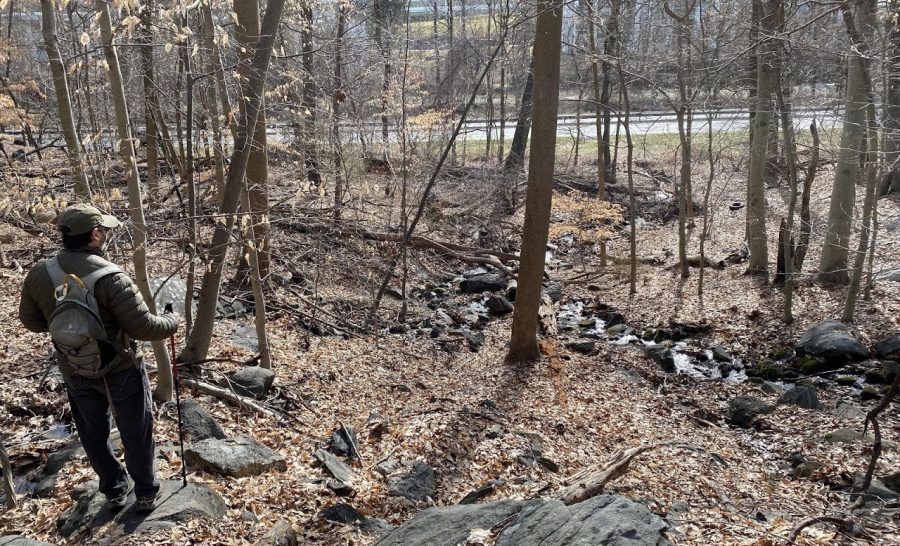Our Dying Woods
December 13, 2020
Hillside Woods, once teeming with life and covered in undergrowth, is dying.
Almost everyone who’s been on walks through our so-called ‘forest’ has noticed this, whether it was the uninterrupted view for hundreds of feet through sparsely populated trees or the sickly color of their leaves that gave it away. But why is the health of our woods so poor? How has a once lush forest been hurt so much? Simply put, there are three main issues plaguing our woods: sickness, invasive species, and an overpopulation of deer.
If you look closely at the leaves of beech trees in Hillside Woods, you might see characteristics of striping, curling, and/or leathery texture. This isn’t normal. Rather, these are signs of beech leaf disease, an emerging tree disease that was only recently discovered. It’s caused by a nematode, or a microscopic worm, but how it spreads is still unknown and there is no cure. These deformed leaves will have a much lower photosynthetic capacity, preventing the trees from producing the carbohydrates they need, which in turn makes them more susceptible to other invaders like fungus and insects. Affected leaves usually turn yellow, wither and die rapidly, and every tree infected will likely be dead in 5-10 years.

“Beech leaf disease is especially concerning because beech trees constitute a large part of our local tree population: about 11% of Hillside Woods is American beech, and they are the fifth most common species of trees in all of NYS,” says Róisín O’Flaherty, a senior and an active member of Protect Our Woods, a community organization whose goal is to restore Hillside Woods and to inform the community about them. She’s also one of the main contributors to the website hastingsgreen.org, where you can go to learn more about the work they’re doing. She also explained that the ramifications of infected beech trees are severe and have ripple effects: “Beeches are a valued nesting site for birds and provide food for a variety of wildlife, including squirrels, birds, and deer. Losing [them] will be devastating.”
The second major cause behind the deteriorating condition of Hillside Woods is invasive species. But why are new species in Hillside a problem? Don’t we have too few trees to begin with? It’s not that simple. According to Róisín, “Invasive species… compete with native plants, offer little to nothing to native animals, and decrease the biodiversity of an area.” Without this rich biodiversity in animal and plant species, Hillside woods will stay dead. If it is ever to fully regrow, these unwanted trees need to be removed. Walkers in Hillside will likely have seen some already, even if they didn’t recognize them for what they were at the time. In fact, many of the trees in Hillside Woods have white lines painted on them, marking them as invasive species that will need to be cut down. Trained volunteers from Protect Our Woods have identified two such ones so far that are particularly harmful: Norway Maple and Tree of Heaven, also known as Ailanthus. (If you want to learn more about how to spot these trees, you can read more here.)
The Norway Maple is a seasonal tree that resembles its cousin, the sugar maple. It’s harmful to other trees as it produces many leaves early on, creating a large shadow that prevents sunlight from reaching other native plants and keeps them from growing. “In a domino effect, this also affects native birds and insects, who depend on these native plants for food,” says Róisín. The other invasive tree species, the Tree of Heaven, disrupts the ecosystem in a different way: by secreting chemicals into the ground that stop the growth of other plants. “Quite rude, really,” comments Róisín on it. It also has a deep root system, which makes it particularly hard to remove. However, Róisín wants to emphasize that this doesn’t mean it’s impossible to get rid of. “With the time and dedication of many, both the tree of heaven and the Norway maple can be removed and our woods can become a happier, healthier place.”


Unfortunately, trees aren’t the only invasive species that are harming Hillside Woods. There are many insects that don’t belong as well (a list of which can be found here) and are causing some problems for the ones that do. The invasive jumping worm, originally from Japan and Korea, is one of these. These worms inhabit the uppermost layer of soil and consume everything that comes in their path. This, along with the fact that the worms raise the soil’s pH, makes it more difficult for seeds to take root and for native species to grow. Other insects such as the Emerald Ash Borer, which feeds on the inner bark of trees, and the Spotted Lanternfly, which encourages the growth of black mold in the trees, are also rapidly killing them. The latter insect is especially devastating, and if you see any you should email [email protected] immediately.

Finally, the large deer population present in Hastings is keeping our woods from regrowing properly, even if the invasive species were removed from the woods. I spoke with Haven Colgate about this, a leading and very active member in Protect Our Woods, as well as one of the Hillside Woods Steering Committee’s Conservation Commission liaisons. “The deer are essentially the biggest danger to the woods (next to humans),” she says. “Every plant that they’re willing to eat is essentially munched out of existence, and then the species they don’t eat have free reign to colonize. It’s why we have the community of plants in the park that we have now, and it’s why we have no native baby trees.”
So, if we have too many deer at the moment, what is a good number? “For a healthy understory to rebound, there needs to be fewer than 20 deer per square mile, and some say 6-10. In 2013, it was estimated Hastings’ two square miles — 1.8 if you don’t include the .2 sq miles in the Hudson — contained 70-120 deer. Most of that acreage is human habitat, of course; Hillside Woods is only 0.15 square miles. While the deer immunocontraceptive project has had some impact, the foresters we consulted said only an exclosure will restore the woods.” This fence around the woods would remove a lot of pressure on them, allowing the trees and undergrowth to recover, and hopefully allow many other native insects and animals to return with them. Without this, Hillside woods will continue to be a “zombie forest,” as Haven put it.
Protect Our Woods is working hard to save our forest and prevent this from happening. This includes removing disruptive plants like privet, honeysuckle, and rampant vines, marking invasive trees, planting native species, and working with Hastings schools to educate students about this problem. The organization has also been raising money to further inform the public, and so far has built a kiosk full of information right by Chemka Pool.
I spoke with Haven about what Protect Our Woods is hoping to do next. “Once invasive removal and tree work are complete, the next step is to enclose the park from deer. This will be done with many S-gate entrances so that people and dogs will not be kept out! We have been promised grant money from the county and state; state funds are understandably frozen, but we expect some county money at the end of the year and will use it to cordon-off a demonstration site area along Edgewood Avenue. If all goes according to plan, we will replant there next spring, and be able to see what the rest of Hillside Woods might look like several years from now.”
If you want to chip in and help restore our woods, Haven runs “work sessions every other weekend, and everyone’s invited!” According to her, “people find the work and camaraderie uplifting, especially since indoor socializing and gyms are complicated by the pandemic. It’s great to have an option for exercise and for safely being with people that also has a constructive impact, and students can also accrue community service hours by participating.” (She mentioned that this might be especially appealing to juniors who are interested in applying to the National Honor Society). If you’re interested in helping out, you can sign up to pull privet and bust barberry here! Haven also wants to make the point that individuals can help the woods in smaller ways: “It would be fantastic if dog walkers would clean up after their dogs and keep them on leashes in the woods; free-running dogs disturb wildlife and dog poop alters soil chemistry, causes algal blooms and introduces diseases.” She also says that people should be careful with their own gardens as often ornamental plants escape and are introduced into the wild where they disrupt the natural ecosystem.
At the end of the day, Hillside Woods offers countless benefits to our community. For one, Haven believes that as a community that prides itself on being sustainable, “restoring the woods is part of that ethos.” Ecologically, Hillside Woods is also important for many animals. “Hastings is situated along the migratory paths of many species of birds and other animals, so preserving the woods helps the region preserve its ecological integrity.” Finally, Hillside is also valued by residents of Hastings for the beauty and solace it offers, the recreational options it allows, and the educational opportunities it provides in teaching people about ecology and environmental science. At the end of the day, “choosing to restore the woods is essentially a choice that reflects what we care about,” says Haven. Let’s show that we care.


















